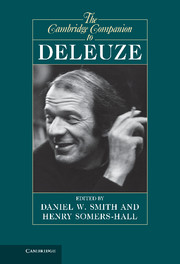Book contents
- Frontmatter
- Contents
- Contributors
- Abbreviations
- Introduction
- 1 Deleuze and the history of philosophy
- 2 Difference and Repetition
- 3 The Deleuzian reversal of Platonism
- 4 Deleuze and Kant
- 5 Phenomenology and metaphysics, and chaos
- 6 Deleuze and structuralism
- 7 Deleuze and Guattari
- 8 Nomadic ethics
- 9 Deleuze’s political philosophy
- 10 Deleuze, mathematics, and realist ontology
- 11 Deleuze and life
- 12 Deleuze’s aesthetics of sensation
- 13 Deleuze and literature
- 14 Deleuze and psychoanalysis
- 15 Deleuze’s philosophical heritage
- Bibliography
- Index
- References
6 - Deleuze and structuralism
Published online by Cambridge University Press: 05 December 2012
- Frontmatter
- Contents
- Contributors
- Abbreviations
- Introduction
- 1 Deleuze and the history of philosophy
- 2 Difference and Repetition
- 3 The Deleuzian reversal of Platonism
- 4 Deleuze and Kant
- 5 Phenomenology and metaphysics, and chaos
- 6 Deleuze and structuralism
- 7 Deleuze and Guattari
- 8 Nomadic ethics
- 9 Deleuze’s political philosophy
- 10 Deleuze, mathematics, and realist ontology
- 11 Deleuze and life
- 12 Deleuze’s aesthetics of sensation
- 13 Deleuze and literature
- 14 Deleuze and psychoanalysis
- 15 Deleuze’s philosophical heritage
- Bibliography
- Index
- References
Summary
INTRODUCTION
In the years between 1966 and 1969, Deleuze was close to the work of the structuralists, while at the same time he was aware of their impasses, rejecting any closure of sense or any reduction to a binary mode of thought that would be closed to both the process of temporalization and the pragmatic dimension of language. Deleuze’s encounter, in 1969, with his friend Félix Guattari itself constituted a veritable war machine against structuralism. Guattari, as a Lacanian and a member of the Freudian school, participated fully in the propagation of structuralism in his form of psychoanalysis. As for Deleuze, his desire to leave the history of philosophy made him very receptive to the ongoing tumult in the humanities. For him, the figure of the schizophrenic became a question in both its clinical form and its literary form. But neither Deleuze nor Guattari could be satisfied with a simple adherence to the dominant theories of the time. Just before their encounter in 1969, the position they were both expressing was already a lively critique of structuralism.
MACHINE CONTRA STRUCTURE
By the time Guattari spoke before the members of the Freudian School of Paris in 1969, he had already broken with Lacan’s formalist and logicist development of it. He was no longer the heir apparent of the Master, who preferred his son-in-law Jacques-Alain Miller and his circle at the École normale supérieure on rue d’Ulm, which had just launched the Cahiers pour l’Analyse. Guattari called his talk, whose title alone evokes his target, “Machine and Structure,” although it might as well have been called “Machine contra Structure.” In his lecture, Guattari locates blind spots in the grid of structural analysis, and he puts forward the notion of the “machine” in an attempt to think what has been repressed by structuralism, namely, the joint processes of subjectification and the historical event.
- Type
- Chapter
- Information
- The Cambridge Companion to Deleuze , pp. 126 - 150Publisher: Cambridge University PressPrint publication year: 2012
References
- 3
- Cited by

